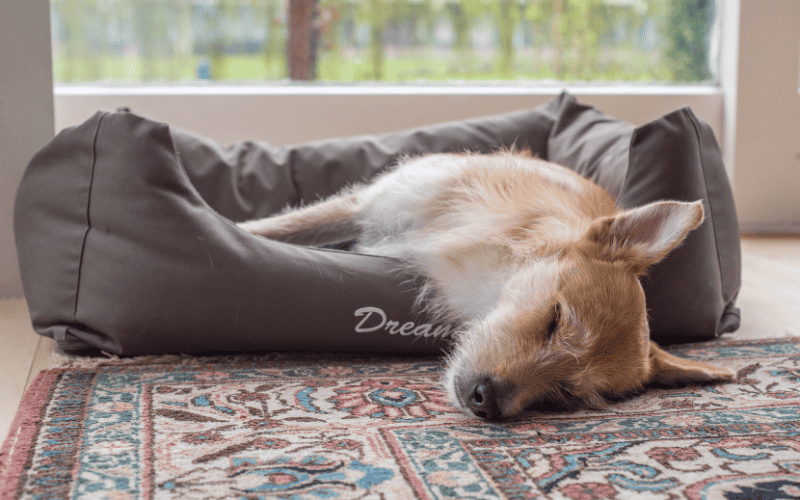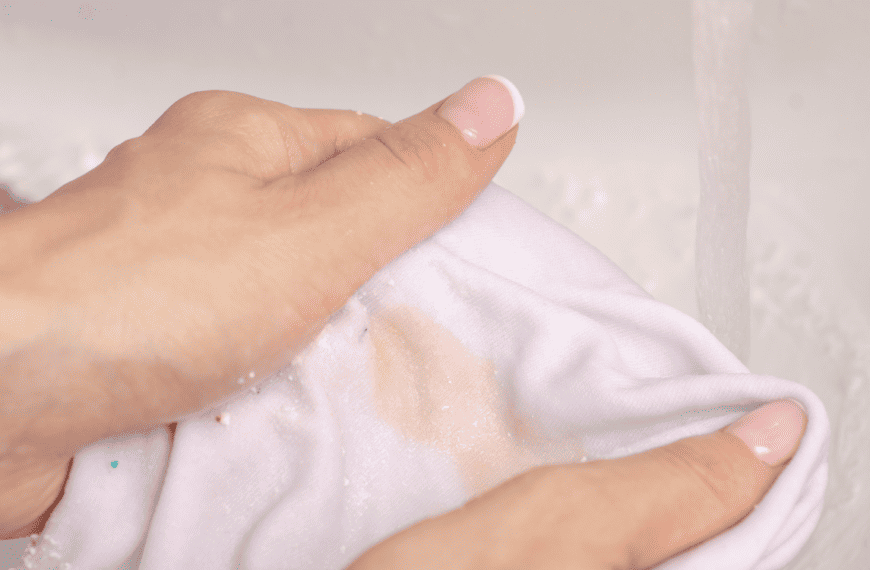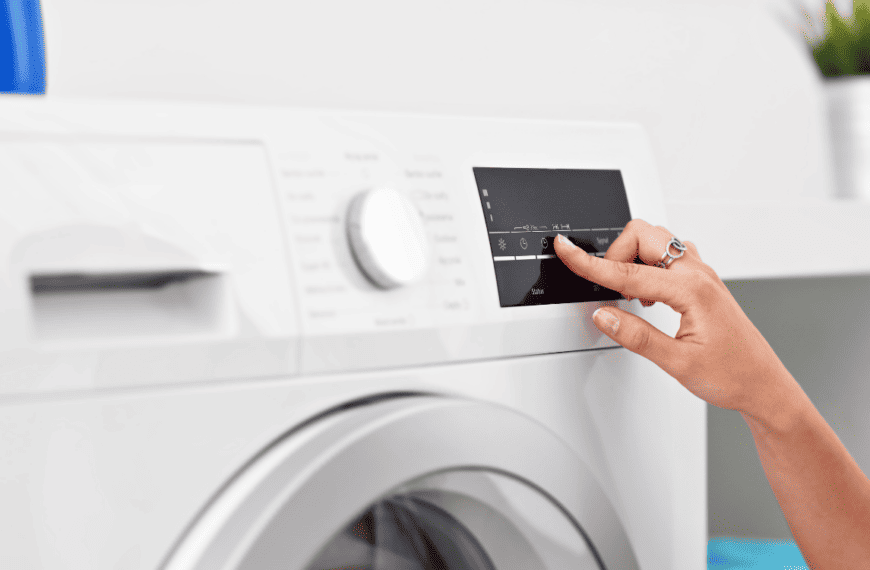Washing your dog’s bed is essential if you want a clean home and a healthy pet. We don’t always notice how dirty our dogs get during the day, much less the collection of pathogens and pests they leave wherever they plop down. Although your pup sleeps on it, everyone benefits when you clean their stinky, stained mattress.
Refreshing your pet’s bedding takes a firm yet gentle approach. Skin allergies and odor sensitivities are common in dogs. You don’t want to make your dog’s bed clean and odor-free with an aggressive cleaning solution only to have it irritate them during nap time. Let’s explore how to wash dog beds to ensure a comfy, cozy, and clean spot for your furry friend.
How to Wash a Dog Bed
The proper approach to washing dog beds depends on whether it has a removable cover. Most dog beds will have one, making it easy to machine-wash.
Non-removable dog bed covers are a little trickier. Some beds are hand-wash only, and even those you can put in a washing machine may not be compatible. An agitator can rip up dog beds, and many washers will be too small to fit them.
Tools and Supplies
- Vacuum with a brush attachment
- Enzyme cleaner or a mild stain remover
- Pet-safe laundry detergent, such as Seventh Generation Free & Clear
Step 1: Vacuum Dog Hair and Fur
Before washing your dog’s bed, use your vacuum cleaner with the brush attachment to clear away dry dog fur, dander, and loose dirt. Shaking and banging the dust and dirt out of the bed outside is also a good idea if you can’t vacuum it.
Step 2: Spot Clean Pet Stains
If you’ve read our articles on handling tough pet stains like dog diarrhea, you know an enzyme cleaner is an indispensable part of your arsenal. Active enzymes break down all kinds of organic messes that might appear on a dog bed, including pee, puke, and poop. Products like Angry Orange work on carpets, furniture, mattresses, and dog beds to remove organic stains and the odors they carry.
If you don’t have an enzyme cleaner, you can pre-treat tough stains with mild dish liquid or laundry detergent. Avoid products with bleach and other harsh chemicals that could irritate your dog’s skin.
Step 3: Wash the Dog Bed
Machine washing may be possible whether the cover is removable or not. Check the care label for instructions. Hopefully, you’ll be able to put the entire bed in the washer if the cover doesn’t come off.
Of course, your ability to use your washing machine will also depend on the size of your dog bed versus the size of the appliance. For larger beds, you may need a special trip to the laundromat.
How to Wash a Removable Dog Bed Cover
- Choose a fragrance-free, pet-safe detergent that won’t harm your dog’s sensitive skin
- Wash the dog bed cover in a gentle cold water cycle. If you’re worried about mites, fleas, and other pests, use the hottest water allowable according to the care label
- Add an extra rinse cycle to get all of the detergent out of the bed cover
How to Hand-Wash a Dog Bed with a Non-Removable Cover
- Fill a basin or the bathtub with hot or warm water
- Add pet-safe detergent to the water
- Soak the entire bed in the soapy water for 10–20 minutes, agitating occasionally to cover every inch
- Use a scrub brush on tough stains and soil patches
- Rinse thoroughly with cold water
- Squeeze out excess soap as you rinse
Step 4: Dry the Dog Bed
The best way to dry a pet bed is to hang it in a sunny, breezy spot to let it air dry. You can also tumble dry pet beds on a high setting if you’re still worried about nuisances like fleas and their eggs. Always check the label carefully beforehand to ensure it can handle the heat.
Should you choose the dryer, inspect the dog bed’s cover for discoloration or soil after the washing cycle. You don’t want to pop it in the dryer if the washer didn’t clean all the stains, or it could set them permanently.
Tips for Cleaning Your Pet’s Bed
- Vacuum regularly to remove pet hair, dust, dirt, and other allergens and the odors they carry. A lint roller or duct tape can also make a convenient pet hair remover, as can a dog hair removal brush like this one from YUAKUOD.
- Sprinkle baking soda on your dog’s bed when it develops a funky pet odor. Let it sit for an hour or more before vacuuming.
- Let your dog bed bathe in direct, unfiltered sunlight to deodorize and kill germs
- Use a blanket or waterproof cover to keep your dog bed clean
- Use a steam cleaner without removing the dog bed cover to clean stains, sanitize, and kill insects and eggs
- Remove pet accidents and stubborn stains with an upholstery cleaner like this one
- Clean dog accidents immediately to prevent visible stains and recurring odors. Use a pet stain remover like an enzyme cleaner or Resolve Ultra Pet Stain & Odor Remover Spray
Check the care tag for washing instructions, and use our guide and tips to ensure your pet’s bed comes out clean and undamaged. The following video from L.L. Bean offers an excellent overview of the general cleaning process:
How Often Should I Wash My Dog’s Bed?
Wash your pet bed once every 1–2 weeks to keep it clean, odor-free, and safe for your dog. Play it by ear, washing your dog’s bed cover more often if they’re active and adventurous and giving it a special cleaning whenever they have an accident. Vacuum it frequently, especially during the heavy shedding season.
Is It OK to Wash a Dog Bed in the Washing Machine?
As long as the instructions allow it, you can wash a dog bed in the washing machine. Hot water over 130°F is necessary to kill fleas, ticks, and their egg, but cold water will suffice for mild cleaning needs.
What Is the Best Laundry Detergent for Dog Bedding?
Dogs have sensitive skin and an acute sense of smell, two important considerations when you’re picking out laundry detergent. A free and clear formula without aggressive cleansers or fragrances is our top choice, but you can also whip up a homemade detergent that can be equally gentle on your dog’s skin.
What Is the Best Way to Clean a Large Dog Bed?
If it doesn’t have a removable cover, you have two options for washing a large dog bed — the bathtub or the laundromat. Fill your bathtub with warm or hot water, add some liquid detergent, and soak the bed for several minutes. You can also add baking soda to boost the detergent’s efficiency and remove odors more effectively. Rinse the dog bed thoroughly, and air dry it.
How Do You Dry a Dog Bed After Washing It?
Air drying in the sun or tumble drying on a delicate low-heat cycle are the best ways to dry dog beds, as long as the tag allows for machine drying. High heat is necessary for at least one hour to kill fleas and ticks.
How to Wash the Foam in a Dog Bed
You generally can’t wash a foam core without the risk of damaging it. Instead, wash the foam in warm soapy water in a bathtub or basin. Rinse it thoroughly with cold water, ensuring you squeeze all the suds out. Place it in a bright, breezy spot until it dries completely.
If you have an intense pee or puke stain that seeped through the dog’s bed cover to the foam, hit it with your enzyme cleaner, and blot it with a clean cloth. Sprinkle with baking soda to suck up excess moisture and deodorize the spot.
How to Deodorize a Dog Bed You Can’t Wash
Baking soda and white vinegar are two of our favorite household deodorizers and an excellent starting point in beating persistent dog bed smells. Mix a combination of vinegar and water in a spray bottle in a 1:10 ratio to spritz all over the bed. Let it dry entirely to clear the vinegar smell and the foul odors away.
You can also sprinkle baking soda over the sleeping surface to let it deodorize and absorb moisture. Let it sit for an hour or so before vacuuming.









